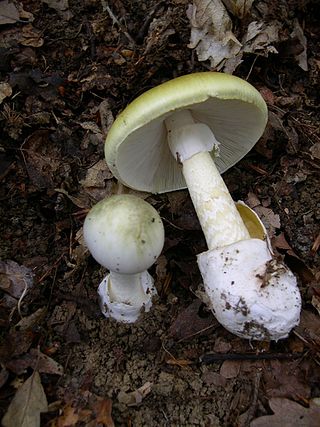
Amanita phalloides, commonly known as the death cap, is a deadly poisonous basidiomycete fungus, one of many in the genus Amanita. Widely distributed across Europe, but introduced to other parts of the world since the late twentieth century, A. phalloides forms ectomycorrhizas with various broadleaved trees. In some cases, the death cap has been introduced to new regions with the cultivation of non-native species of oak, chestnut, and pine. The large fruiting bodies (mushrooms) appear in summer and autumn; the caps are generally greenish in colour with a white stipe and gills. The cap colour is variable, including white forms, and is thus not a reliable identifier.

The genus Amanita contains about 600 species of agarics, including some of the most toxic known mushrooms found worldwide, as well as some well-regarded edible species. The genus is responsible for approximately 95% of fatalities resulting from mushroom poisoning, with the death cap accounting for about 50% on its own. The most potent toxin present in these mushrooms is α-Amanitin.

The Amanitaceae is a family of mushroom-forming fungi. Amanita Pers. is one of the most speciose and best-known fungal genera. The family, also commonly called the amanita family, is in order Agaricales, the gilled mushrooms. The family consists primarily of the large genus Amanita, but also includes the smaller genera Amarrendia, Catatrama, Limacella, Limacellopsis, Saproamanita, Torrendia and Zhuliangomyces. Both Amarrendia and Torrendia are considered to be synonymous with Amanita but appear quite different because they are secotioid.
Amatoxin is the collective name of a subgroup of at least nine related toxic compounds found in three genera of poisonous mushrooms and one species of the genus Pholiotina. Amatoxins are very potent, as little as half a mushroom cap can cause severe liver injury if swallowed.

Amanita calyptroderma also known as coccora, coccoli or the Pacific amanita, is a white-spored mushroom that fruits naturally in the coastal forests of the western United States during the fall and winter and spring.
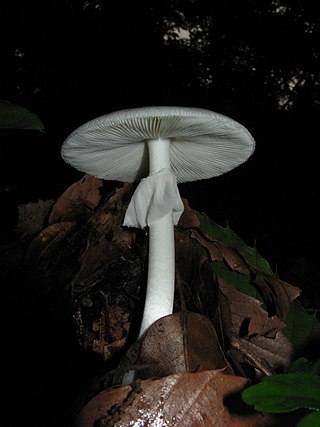
Amanita verna, commonly known as the fool's mushroom or the spring destroying angel, is a deadly poisonous basidiomycete fungus, one of many in the genus Amanita. Occurring in Europe in spring, A. verna associates with various deciduous and coniferous trees. The caps, stipes and gills are all white in colour.

Amanita ocreata, commonly known as the death angel, destroying angel, angel of death or more precisely western North American destroying angel, is a deadly poisonous basidiomycete fungus, one of many in the genus Amanita. The large fruiting bodies generally appear in spring; the cap may be white or ochre and often develops a brownish centre, while the stipe, ring, gill and volva are all white. A. ocreata resemble several edible species commonly consumed by humans, increasing the risk of accidental poisoning. Mature fruiting bodies can be confused with the edible A. velosa, A. lanei or Volvopluteus gloiocephalus, while immature specimens may be difficult to distinguish from edible Agaricus mushrooms or puffballs.
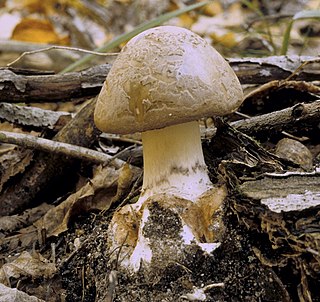
Amanita brunnescens, also known as the brown American star-footed amanita or cleft-footed amanita is a native North American mushroom of the large genus Amanita. It differs from A. phalloides by its fragile volva and tendency to bruise brown.

Amanita arocheae, also known as the Latin American death cap, is a mushroom of the large genus Amanita, which occurs in Colombia, Central America and South America. Deadly poisonous, it is a member of section Phalloideae and related to the death cap, A. phalloides.

Amanita bisporigera is a deadly poisonous species of fungus in the family Amanitaceae. It is commonly known as the eastern destroying angel amanita, the eastern North American destroying angel or just as the destroying angel, although the fungus shares this latter name with three other lethal white Amanita species, A. ocreata, A. verna and A. virosa. The mushroom has a smooth white cap that can reach up to 10 centimetres across and a stipe up to 14 cm tall with a white skirt-like ring near the top. The bulbous stipe base is covered with a membranous sac-like volva. The white gills are free from attachment to the stalk and crowded closely together. As the species name suggests, A. bisporigera typically bears two spores on the basidia, although this characteristic is not immutable. A. bisporigera closely resembles a few other white amanitas, including the equally deadly A. virosa and A. verna.

Amanita aestivalis, commonly known as the white American star-footed amanita, is a species of fungus in the mushroom family Amanitaceae. The cap of the white fruit body is 5 to 8.5 centimetres in diameter. It sits atop a stem that is 8.5 to 16 cm long. The entire fruit body will slowly stain a reddish-brown color in response to bruising. A. aestivalis may be a synonym for A. brunnescens, and may be confused with several other white-bodied amanitas. The fungus is distributed in eastern North America.

Amanita exitialis, also known as the Guangzhou destroying angel, is a mushroom of the large genus Amanita. It is distributed in eastern Asia, and probably also in India where it has been misidentified as A. verna. Deadly poisonous, it is a member of section Phalloideae and related to the death cap A. phalloides. The fruit bodies (mushrooms) are white, small to medium-sized with caps up to 7 cm (2.8 in) in diameter, a somewhat friable ring and a firm volva. Unlike most agaric mushrooms which typically have four-spored basidia, the basidia of A. exitialis are almost entirely two-spored. Eight people were fatally poisoned in China after consuming the mushroom in 2000, and another 20 have been fatally poisoned since that incident. Molecular analysis shows that the species has a close phylogenetic relationship with three other toxic white Amanitas: A. subjunquillea var. alba, A. virosa and A. bisporigera.
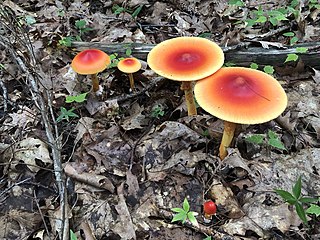
Amanita jacksonii, also known as Jackson's slender amanita, American Slender Caesar, and Eastern Caesar's Amanita, is a North American species of fungus in the family Amanitaceae. It is a reddish-orange colored mushroom species which can be identified by its yellow gills, large, white, sacklike volva.
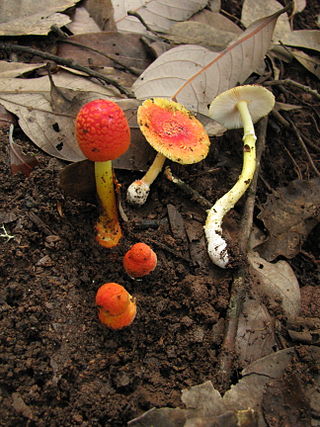
Amanita rubrovolvata, commonly known as the red volva amanita, is a species of fungus in the family Amanitaceae. The fungus produces small to medium-sized mushrooms, with reddish-orange caps up to 6.5 millimetres wide. The stems are up to 10 cm (4 in) tall, cream-coloured above the ring and cream to yellowish below it. The stem ends in a roughly spherical bulb at the base, which is covered with bright orange patches.
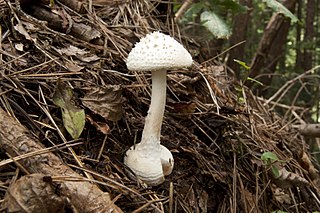
Amanita sphaerobulbosa, commonly known as the Asian abrupt-bulbed Lepidella, is a species of agaric fungus in the family Amanitaceae. First described by mycologist Tsuguo Hongo in 1969, it is found in Southern Asia.

Amanita fuliginea, commonly known as the east Asian brown death cap, is a species of deadly poisonous mushroom in the family Amanitaceae. The fruit bodies have convex, dark gray to blackish caps measuring 3–6 cm (1.2–2.4 in) in diameter. The gills, largely free from attachment to the stipe, are white and have short gills (lamellulae) interspersed. The spores are roughly spherical, amyloid, and typically measure 8–11 by 7–9.5 µm. The species was described as new to science by Japanese mycologist Tsuguo Hongo in 1953. A. fuliginea is classified in Amanita section Phalloideae, which contains the infamous destroying angel.

Amanita manginiana, also known as Mangin's false death cap, Chiu's false death cap, is a species of the genus Amanita.

Amanita chrysoblema, with the common name American fly agaric, white variant, is a basidiomycete fungus of the genus Amanita. Although named chrysoblema, it is traditionally thought to be an Amanita muscaria variant, a group of fungi commonly known as fly agarics.

Amanita princeps, the head man slender Caesar, is a species of agaric fungus in the genus Amanita. It is found in tropical China, Southeast Asia, and the Malay Peninsula down to Singapore. It is edible, and is collected in the wild and sold in local markets. Many incidents of mushroom poisoning have occurred among Laotian and Hmong immigrants to North America, since it is easily confused with Amanita phalloides, the death cap, in both appearance and odor.




















